
A new spin-out from Oxford University, Spinox, is aiming to devise novel ways to copy spiders` ability to spin silks. The new silks may be used for sutures or woven material for surgical implants, protective clothing and in sports equipment.
Spinox has been set up to fully develop a spinning process to create high performance fibres from natural or artificial proteins based on the principles used by spiders and insects to create natural silk fibres. This approach – biomimetic (mimicking biology)

Materials scientists at the University of Wales Aberystwyth (UWA) are taking ceramics to new heights in order to determine the structure and stability of the materials which are used to construct aeroplane engines and the tiles for the space shuttle.
Dr Rudi Winter and colleagues from the Department of Physics at UWA are using a unique combination of techniques to study the materials at extreme temperatures which simulate those experienced when aircraft travel at high speed or when they dec

Europe is one step ahead of the US in the development of a new type of semiconductor structure consisting of incredibly thin nano threads. A Swedish team headed by Professor Lars Samuelson at the LTH, the Lund Institute of Technology, Lund University, has taken the lead in this field of research. “In nano threads, we can combine semiconductor materials that no one has previously been able to grow. This results in entirely new electrical properties: a single electron can be monitored and made to run a

From cutlery and cooking pans to the inside of a Formula 1 car engine or a huge chemical process plant, stainless steel is all around us. It’s not meant to corrode, but it can, and when it does the results can be disastrous, whether it’s a hole in your dishwasher or a failed industrial plant.
Unlike rusting, stainless steel corrosion is highly localised and apparently random. Tiny holes called pits can drill through a substantial thickness of steel in a relatively short time. The pits can ca

The use of halogenated flame retardants in plastics is steadily declining because they are volatile, pose an environmental risk and are difficult to recycle. Microcapsules, fibers and melamine resin foams represent some of the chief alternatives.
As successfully as the endless variety of plastics have established themselves on the market, these multifaceted materials show another face when it comes to fire. They melt and feed the flames like the petroleum from which they were ultimately pro

Oxygen and light can alter the taste of foodstuffs. Manufacturers of packaging materials therefore try to protect contents from their influence. The latest approach is to use natural dyes in transparent plastic wrappers that selectively filter light.
Light and oxygen adversely affect the quality of most foodstuffs. In combination they cause various ingredients to undergo photo-oxidation. Fatty food substances become rancid and milk products develop an unpleasant “light-induced” taste. Certai
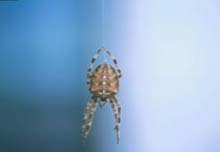
Few things appear as delicate as a spider’s web, each gossamer strand one-tenth the width of a human hair. Yet pound for pound, the sturdiest spider silks are stronger than steel and stretchier than nylon. With such remarkable properties, it’s no wonder that researchers have made numerous attempts to synthesize spider silk for industrial and medical applications. (Efforts to farm the arachnids have failed as a result of their territorial nature.) Indeed, in the words of one scientist, this
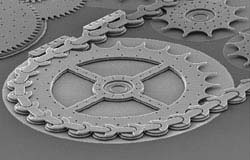
Scientists have manufactured a microscale bicycle chain comprised of silicon links thinner than a human hair that behaves just like its regular-sized counterpart. The tiny chain system could one day help power microscopic devices.
Ed Vernon, a technologist at Sandia National Laboratories, designed and patented the 50-link silicon microchain (see image), which was built by the lab’s Microelectronics Development Laboratory (MDL). The centers of the tiny links are separated by just 50 mic
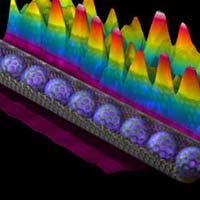
In yet another small step toward building nanoscale devices, scientists have determined that nanotube peapods — minute straws of carbon filled with spherical carbon molecules known as buckyballs — have tunable electronic properties. Published online by the journal Science,the findings suggest that stuffing the straws provides greater control over the electronic states of single-walled carbon nanotubes (SWNT).
Using a low-temperature scanning tunneling microscope, Ali Yazdani of the Univers
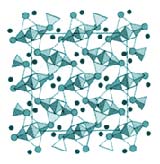
Logic dictates that when you increase the pressure acting on a material, it should compact. So a report from an international team of scientists that they have discovered a crystal formation that expands under pressure is intriguing. The counterintuitive behavior may be exploited to make a crystal sponge for chemical cleanup.
Writing in the December 19 issue of the Journal of the American Chemical Society, the researchers describe the behavior of natrolite, a type of zeolite, under increasi

An experiment that University of Chicago physicists conducted just for fun has unexpectedly led them to a new technique for producing nanoscale structures.
The Chicago physicists have built simple electronic devices using the new technique, which precisely controls the growth of metal wires along tiny scaffolds that automatically assemble themselves following nature’s own tendencies.
“This is perhaps the first time that it has been possible to assemble large numbers of parallel, contin
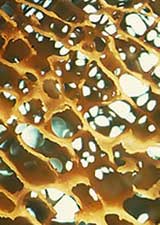
Programmed molecules build themselves into a bone-mimic.
Scientists in the United States have made self-assembling synthetic bone 1 . Carefully designed building-blocks join up to mimic bone’s complex molecular-scale architecture, bringing better prosthetics a step closer.
Materials engineers are keen to emulate the strength and toughness of biominerals such as bone, tooth and shell. Mollusc shells, for example, a composite of the mineral calcium carbonate a
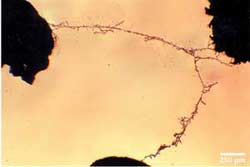
Scientists can coax tiny metal particles to self-assemble into microscopic wires that conduct electricity and repair themselves, new research reveals. Kevin D. Hermanson of the University of Delaware and his colleagues, who published their finding in the current issue of Science, suggest that such nanowires may prove useful for wet electronic and bioelectric circuits.
The researchers placed particles of gold ranging in diameter from 15 to 30 nanometers in a fluid suspension within a thin ch